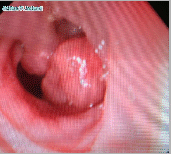 |

A polyp is simply a mass of tissue that proturdes into the bowel lumen. It is not a diagnosis it is an appearance. Polyps are in the main identified on colonoscopy and on enema studies. Colonoscopy is particularly useful because it may be possible to remove the polyp endoscopically. Small polyps may be eaten by repeated bites of the biopsy foreceps. The application of diathermy `hot-biopsy' will kill more of the surrounding tissue. Larger polyps may be removed with the snare. Special instruments (suction traps, baskets, prongs) have been devised to aid in the retrieval of polyps that have been taken off the bowel wall. If the polyp is too large for the biopsy forceps and too small and flat to get the snare on the endoscopist may inject saline under the polyp to make it more polyp like, then snare it.
It has been estimated that 1 cancer is saved for every 36 polyps removed.
The macroscopic appearance of a polyp may be either sessile (flat) or pedunculated (sticking out). Sessile polyps have a greater chance of being malignant than pedunculated polyps.
Histologically, colonic polyps may be divided into;
The jeuvenile polyp is a type of polyp with doubtful malignant potential. Similar polyps occur in Jeuvenile Polyposis but that is a totally different condition. The serrated adenoma has the same significance as an adenomatous polyp.
